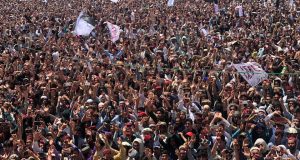 Pashtuns and modernity as a subject offers immediate pitfalls. It is profuse with cultural distinctiveness and idiosyncrasies, and may prove quite difficult at times for any learned foreign observer to grasp. On the other hand, from a Pashtun point of view, the outer world sometimes seems needlessly complex and tangled, irrationally busy, and while abundant in riches, psychologically as horrible as Kafka and Beckett could have it depicted, a mathematically rational construct on entirely baseless foundations.
Pashtuns and modernity as a subject offers immediate pitfalls. It is profuse with cultural distinctiveness and idiosyncrasies, and may prove quite difficult at times for any learned foreign observer to grasp. On the other hand, from a Pashtun point of view, the outer world sometimes seems needlessly complex and tangled, irrationally busy, and while abundant in riches, psychologically as horrible as Kafka and Beckett could have it depicted, a mathematically rational construct on entirely baseless foundations.
Pashtuns are the world’s largest segmentary society, the largest living Eastern Iranian people, and speak the largest living Eastern Iranian language – Pashto. The original religion of Pashtuns was Zoroastrian, in itself Eastern Iranian in origin.
Studies on Pashtun cultural resilience, particularly in the most extreme conditions, such as war-times, have wondered all foreign scholars. They have found this resilience quite enough explanation for how Pashtuns were able to survive to this day, notwithstanding laying across the passage of uncounted invasions, even as standing against the huge imperial powers of history that pressed upon them, while the Mughals, their one time strongest rivals, disappeared. Despite the Central Asian segmentary character of the Pashtuns, one similar with such as Pierre Clastres would call a stateless society or more precisely ‘society-against-state’, it is interesting that modern Pashtun state was established in 1747, much earlier than most of the modern Western states.
Before the Arab invasion of Afghanistan, Pashtun land remained an integral and natural satrapy of the Iranian Empire for continuously eleven centuries – from Achaemenian to Parthian and Sassanian empires. Until the end of the fourth century A.D., all the post-Achaemenian invasions of the Pashtun satrapy, with the only exception of Greek invasion, were from immediate Eastern Iranian nomadic people. They include Parthians, Scythians, Kushans and Bactrians. The latter though with a Hellenic veneer. What is more, for the most part all these nomadic empires were nearly co-religionists of the Pashtun people, except that the Scythian religious believes were more archaic than the Zoroastrian reforms of the earlier centuries, yet the highest deity of the Scythian tribes was still Atar, the pantheon of fire.
From the further north, towards the end of the fourth century A.D, the first non-Iranian outsiders invaded Eastern Iran, including the Pashtun satrapy. They were called Haytal by Iranians and Arabs, White Huns by Indians, and Ephthalites by Romans. The Chinese sources make distinction between White Huns and the Huns proper, mentioning that White Huns neither spoke Turkish nor Mongolian. Modern research however is of the opinion that Ephthalites were, even at the time of invasion, somehow Iranized people of the Turkic stock, and spoke a Turko-Iranian language. This is much similar like Mughals, who were Iranized people of the Turkic stock, and spoke Dari (Afghan Persian). Until 11th century A.D, Ephthalites, who had by now completely iranized, gradually disappeared in the local population.
The Sassanid emperor Khusrau Anushirvan decisively defeated Ephthalites in A.D. 568 and restored the Pashtun satrapy to the Iranian empire. However, the changes that Ephthalites brought in its wake to the Pashtun satrapy remained more profound, but, although I will come to that in the next article, for the time being suffice it to say that before the Arab invasion Kushan and Ephthalite remnants of power in Afghanistan had adopted Budhism and had also in the final phases come under the influence of Hinduism. There is now evidence that suggests that the greatest of the Budhist Kushan ruler, King Kanishka, had also come at some later stage under the influence of Hinduism. The Chinese traveler Hiuen-Tsang, who visited Peshawar and Kabul in A.D. 644, two years after the last Sassanid emperor Yazdegerd III was decisively defeated by Arab armies at Nihawand, reports that Budhism was fast losing ground here and people as well as rulers were reverting to the cult of Brahmanism.
The Arabian invasion of Iran was for the most part a story of success for the Arabs, except that its Pashtun satrapy proved to be a dismal failure for the Arab forces. Arab armies made some half-successful raids on Zabul, Kabul, and as far as Peshawar and once even Bannu, but on the whole Arab troops could neither become able to hold possessions east of Herat nor south of Balkh. Arab took firm control of Herat, Merv and Balkh, but never held the possession of Kabul. By way of Sistan, Arabs also took the possession of Helmand, Bust, and Arghandab, but failed to take Zabul, Ghor and Ghazni. Furthermore, after the death of Caliph Abdul Malik, the Arab troops also lost the firmness of their hold on Sistan.
Contrary to what is commonly believed, there was no mass conversion of Pashtuns into Islam during the Arab rule of Eastern Iran. The evidence suggests that during the whole period of Arab rule, and even long after that, Pashtuns certainly didn’t have a common Muslim faith; rather they had by now become a multi-religious society with many tribes still adopting, and some having already adopted, Hinduism through the influence of Kushan and Ephthalite remnants, some retained Budhism, others retained Zoroastrianism, and quite a few coming to the new faith of Islam.
And yet the Arabian invasion of Iran was a turning point in the history of Iranian people and also, by extension, South Asia. Henceforth Pashtuns would begin, religiously, to become what they presently are – Muslims. But this will be an Islam Pashtuns would not receive from Arab troops, rather the Islam they would receive, would first pass through the Iranian prism. The conversion of Pashtuns to Islam would be the subject I would undertake in the next article of a series of articles on Pashtun and Modernity.
Writer: Wakeel Khan
Editor: THE PASHTUN TIMES
The writer is a student of Pakistan Studies at Quaid-i-Azam University. He can be reached at
wakeel.peshawar@gmail.com
ALL RIGHTS RESERVED WITH THE PASHTUN TIMES
 Pashtun Times Latest News
Pashtun Times Latest News



